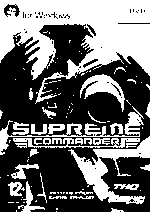 a review of Supreme Commander
a review of Supreme Commander
a videogame developed by chris taylor
and published by thq
for Microsoft Windows and the microsoft xbox 360
text by Carl Bohlin
Supreme Commander takes the RTS genre to its logical short-term conclusion. Want to build 100 amphibious tanks? Okay, just queue that stuff up and you’ll have them in a few minutes. Want to give them all orders at once? Sure, absolutely no problem. There is no upper limit to the amount of units you can have selected at any one time. Want to tell all of your warships with legs that maybe they should head over there for a while, even though they’re scattered all over the (motherhecking insanely gigantic) map? You just zoom out enough that you can see the entire map, which is terribly easy and rewarding, select every unit on the field, click on the warship icon, and there you go!
User empowerment through enhancements to the interface, though, is what this game is about: Taking away all the dumb limitations that hem the strategic thinking and innovation of the player in. The game is like comparing the tabbed, spell-checking, greasemonkey’d, fasterfox’d, adblocked Firefox to the rest of the genre’s Internet Explorer 3.0 for Palm and it’s incredible how easy, fun and rewarding it is to use the tools they’ve given you.

Supreme Commander is a game that really, truly wants to make the people who play RTS games ask themselves just what in the hell it is that they’ve been putting up with for all these years. The standard user interface for this particular genre is still trying to respect the limitations set down by games with a lower resolution than my cellphone. It is like intentionally making paper an inch thick because we used to write on stone tablets — which is kind of puzzling, and makes you wonder if these people actually understand what it they’re making. If they ever play their own creations, or just keep making them as some kind of weird tribute to the games that they liked when they were kids. Take Starcraft for one: The player can only select a tiny amount of units at once, he can only give them a single order, and if he wants to be competitive against even the dumbest AI, he will need to constantly micromanage them. The base-building is slow, inefficient, and needs constant looking after, even though it would be terrible easy to give the player more of an indirect, hands-off building tool. Think something more along the lines of planning the base, and then creating some engineers to do it for you, without needing constant input from you. Instead you are forced to both plan the base out in your mind, give tiny, stupid orders to your builders, and just generally micromanage everything to a terrible degree.
Clearly, this was something that shouldn’t, couldn’t last. Not in such a technophilic environment as game design.
Enter Gas-Powered Games, and let none who experience their creation tolerate anything less than what they have created from now on. And yet, I am afraid that it will be remembered as more of a Dragon Quarter than a Goldeneye. Something that could have shown the entire genre it was spawned from how to save itself: To become something that it should always have wanted to become, yet was ignored and cast away because not enough people bought it, or really got what it was trying to do. This game deserves better than that — but then again, so did Dragon Quarter, and, well, that didn’t mean nothing at all.
I could talk about the individual units, the way there are a million avenues of attack, the way everything plays off of everything else, and how you need to constantly balance your needs with your offensive wants — but that’s not really important here. What’s great about the game isn’t the balance, the units or how you actually play it. I mean, it IS really great, and it’s actually incredibly well done, but none of those things are as innovative and powerful as what the UI achieves. The interface is an amazing example of punctuated equilibrium in game design, how the evolution of a genre can stand still for a long time and then shoot forward at a huge speed with the release of a single game, just because of a few designers reinventing the steering wheel, so to speak. That’s exactly what the RTS genre needed at this point in time, and if their ideas and thoughts are heeded, we are going to see some really interesting things happen to it in the near future, as soon as the lessons of this pretty insanely great piece have been absorbed.
–Carl Bohlin
9 Responses to Supreme Commander